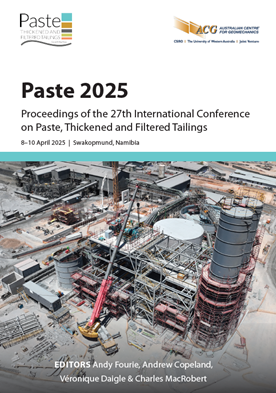Tailings disposal facilities project for a Brazilian niobium mine: innovation and sustainability in tailings management

|
Authors: Almeida, W; Testa, F; Leijoto, D; Lemos, M; Guimarães, R; Alvares, R |
DOI https://doi.org/10.36487/ACG_repo/2555_29
Cite As:
Almeida, W, Testa, F, Leijoto, D, Lemos, M, Guimarães, R & Alvares, R 2025, 'Tailings disposal facilities project for a Brazilian niobium mine: innovation and sustainability in tailings management', in AB Fourie, A Copeland, V Daigle & C MacRobert (eds), Paste 2025: Proceedings of the 27th International Conference on Paste, Thickened and Filtered Tailings, Australian Centre for Geomechanics, Perth, pp. 413-424, https://doi.org/10.36487/ACG_repo/2555_29
Abstract:
Companhia Brasileira de Metalurgia e Mineração (CBMM) is implementing a new tailings disposal facility. The Tailings Storage Facilities 9 (TSF9) project incorporates innovative technologies and engineering practices to optimise safety and efficiency in the management of tailings generated by niobium production. TSF9 includes three main facilities: main dam, with a capacity of 92.8 million cubic metres, and two dry stacking piles with capacities of 16.8 million and 43.5 million cubic metres. The project utilises specific dewatering methods, minimising operational and environmental risks. The tailings were categorised into magnetite, coarse flotation, fine flotation and ultrafine flotation, allowing for more efficient disposal. The physical, chemical and mineralogical characterisation of the tailings was conducted to ensure the best dewatering and disposal solutions for each type of tailings. The magnetic tailings exhibit large, compact grains that drain more easily. In contrast, the flotation tailings, due to their fine granulometry, present challenges in achieving optimal moisture content for compaction, while the coarse fraction of these tailings showed good filtration results. Complementary geotechnical studies, such as compaction and permeability analyses, reinforced the safest techniques for each type of tailings. The solution for the magnetite tailings involves dewatering with hydrocyclones and placement in a specific compacted pile, increasing the potential for re-use as iron ore. Coarse flotation tailings are filtered and placed in compacted piles, while the finer flotation tailings undergo thickening before being disposed of as high-density slurry in the main dam reservoir. The facilities were designed with efficient drainage systems and geomembrane liners to ensure long-term safety. The project also promotes sustainability by re-using materials as byproducts, such as the production of iron ore concentrate.
Keywords: tailings, TSF9, dam, dry stacking piles, magnetite, coarse flotation, sustainability, management
References:
Fourie, AB 2012, ‘Perceived and realised benefits of paste and thickened tailings for surface deposition’, in R Jewell, AB Fourie &
A Paterson (eds), Paste 2012: Proceedings of the 15th International Seminar on Paste and Thickened Tailings, Australian Centre for Geomechanics, Perth, pp. 53–64,
Furtado, RM, Chaves AP, Testa FG & de Paula PT 2023a ‘Feasibility of High-Density and Non-Segregable Niobium Ore Tailings’, Minerals, vol. 13,
Furtado, RM, Chaves, AP, Testa, FG, de Paula, PT & Braga, AS 2023b ‘Dewatering of niobium ore flotation tailings in bench scale’ Proceedings of the Seminars on Reduction, Iron Ore and Agglomeration, Brazilian Association of Metallurgy, Materials and Mining, Sao Paulo, pp. 455–466.
Testa, FG, Júnior, MAL, Furtado, RM & Chaves, AP 2023 ‘Investigation of solids content influence on high density slurries niobium fine tailings disposal’, Proceedings of Tailings and Mine Waste Conference 2023, University of British Colombia, Vancouver.
Watson, AH, Corser, PG, Garces Pardo, EE, Lopez Christian, TE & Vandekeybus, J 2010, ‘A comparison of alternative tailings disposal methods — the promises and realities’, in R Jewell & AB Fourie (eds), Mine Waste 2010: Proceedings of the First International Seminar on the Reduction of Risk in the Management of Tailings and Mine Waste, Australian Centre for Geomechanics, Perth, pp. 499–514,
© Copyright 2025, Australian Centre for Geomechanics (ACG), The University of Western Australia. All rights reserved.
View copyright/legal information
Please direct any queries or error reports to repository-acg@uwa.edu.au
View copyright/legal information
Please direct any queries or error reports to repository-acg@uwa.edu.au
